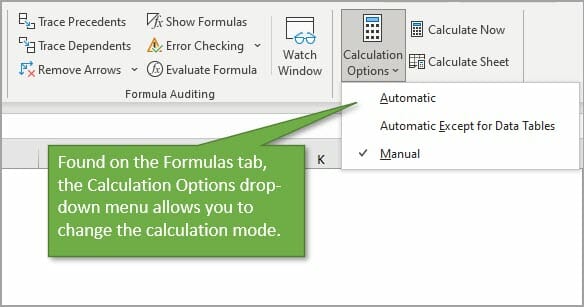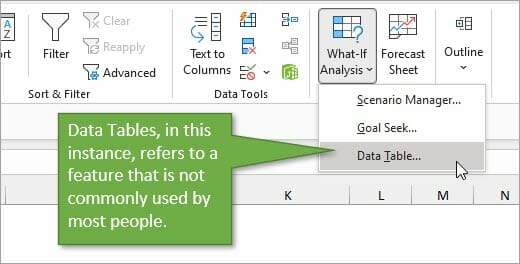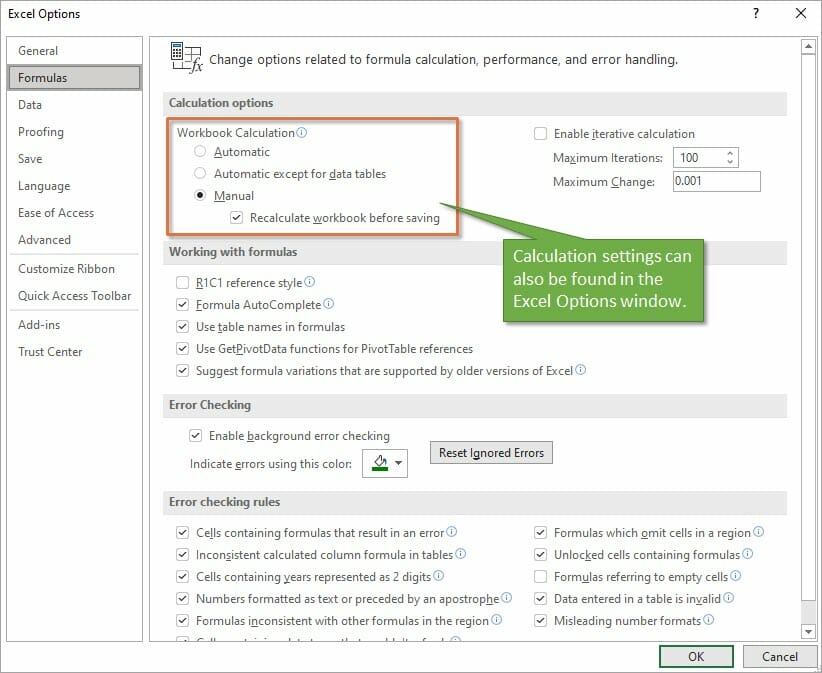Summary:
This article provides complete information about how to fix Excel formulas not updating or calculating automatically and the reasons why the formulas are not updating automatically in Excel.
Microsoft Excel is one of the most useful programs in modern computing but what if Excel is without formulas or imaging using Microsoft Excel without formulas.
Well, I guess no one can, isn’t it…!!!
MS Excel is all about formulas and millions of people use Excel spreadsheets for performing plenty of tasks like maintaining records to advanced data analysis using complex formulas.
So, unquestionably Excel formulas are very vital in Microsoft Excel. But there are cases when the Excel formulas stop working suddenly and trigger various problems related to formulas.
And Excel formulas not updating or Excel formula not calculating is one of them. If you are the one struggling with the same issue then this tutorial is for you.
Just go through the article thoroughly and follow the given fixes one by one to fix Excel formulas not updating issues.
Here check out the possible reasons for the Excel formulas not updating automatically issue:
- Your calculation is configured to “Manual”
- The show formulas button is turned on
- The cell is formatted as Text
- Before the Equal sign, you have entered space.
So these are the common reasons why Excel formulas not updating, now try the given fixes.
How To Fix Excel Formulas Not Updating Issue?
Solution 1: Calculation is Set to “Manual”
This is one of the most common reasons responsible for triggering the Excel formulas not updating automatically.
So, check if the calculation option is configured to “manual” then set to “Automatic” to fix the problem.
Well, the steps may vary as per your Excel version so here follow the steps for the different Excel versions.
- Excel 2003 – Click Tools > Options > Calculation > Calculation > Automatic.
- In Excel 2007 – Click Office button > Excel options > Formulas > Workbook Calculation > Automatic.
- Excel 2010, 2013, & 2016 – Go to File > Options > Formulas > Calculation options section > under workbook calculation > choose Automatic.
Now check if the formulas not updating automatically issue is resolved or not.
Solution 2: Show Formulas Button is Turned On
If the above-given solution won’t work for you then check if the Show Formulas button on the Formulas tab is turned on.
Then also there are chances the formulas do not work or update. Well, this button is mainly used when auditing formulas this displays formulas in place of the end result.
Though, this tab is helpful if fixing formula malfunctioning.
And to change it click Show Formulas button and Turn it Off.
Verify if the formulas not updating in Excel are resolved or not.
Don’t Miss: How to Lock and Unlock Cells, Formulas in Microsoft Excel 2016?
Solution 3: Cell is formatted as Text
If you have accidentally formatted the cells including formulas as Text, then this is what causes the problem. As when the cell is in Text format, the cell will not calculate formulas automatically.
So, click on the cell and of the Home, tab check the Number group > if it displays Text > then change it to General.
And you can now recalculate the formula in the cell by double-click on the cell > press Enter.
Solution 4: Check for Circular References
Check circular reference as this can be another culprit that causes Excel formulas not updating.
The circular reference is a formula that includes itself in its calculation or refers to another cell that depends on itself.
And in some cases, this prevents Excel from calculating the formula. So check it and correct the circular reference and recalculate your spreadsheet.
Solution 5: Space Entered before the Equal Sign
This is the last solution that causes the Excel formulas not updating.
Well, while typing formula if you mistakenly enter a space before the “Equal (=)”, then the formula will not calculate.
This mistake is quite tricky and difficult to notice and left unidentified.
Double click the cell and check if there is a space > delete it and the formula will update.
That’s it the given formulas tips will work for you and the issue is resolved now.
Conclusion:
So, this is all about the formulas not updating automatically.
It is estimated that after following the aforementioned solutions you are able to fix formula not updating in Excel issue.
This is a common issue encountered by regular Excel users once, so now you can tackle them easily.
If, in case you have any additional questions, queries, or fixes concerning the ones presented, then visit our Repair MS Excel blog section.
Priyanka is an entrepreneur & content marketing expert. She writes tech blogs and has expertise in MS Office, Excel, and other tech subjects. Her distinctive art of presenting tech information in the easy-to-understand language is very impressive. When not writing, she loves unplanned travels.
I have a formula in a cell which counts the values in 2 other cells. Normally, after entering in the values in these 2 other cells, the formula cell updates automatically when Enter is pressed or when the cells are clicked out of.
However, for some reason, the value calculated by the formula does not update automatically. I am having to click on the formula bar, then I have to click enter for the formula cell to do its thing.
Why is this happening?
asked Jul 8, 2011 at 9:03
oshirowanenoshirowanen
2,17014 gold badges62 silver badges79 bronze badges
A likely cause is that Calculation is set to manual. To change this to automatic in the various versions of Excel:
-
2003: Tools > Options > Calculation > Calculation > Automatic.
-
2007: Office button > Excel options > Formulas > Workbook Calculation > Automatic.
-
2010 and newer: File > Options > Formulas > Workbook Calculation > Automatic.
On Mac:
- 2008: Excel Preferences > Calculation > Automatically
In some cases you may prefer to keep it set to manual, for example if there are many heavy calculations to perform. In such cases, you can simply press F9 when you want the calculations to update.
TylerH
5421 gold badge7 silver badges20 bronze badges
answered Jul 8, 2011 at 9:08
6
Confirm with Excel 2007: Office button > Excel options > Formulas > Workbook Calculation > Automatic.
Short key to refresh
Ctrl+F9
answered Sep 15, 2013 at 8:24
2
I had a case of this just now on Excel 2010: a particular spreadsheet that would not auto-recalculate. I changed the setting as indicated above; but the auto-recalculate still did not work, and upon rechecking the «Calculation» option, found it had reset itself back to «Manual» all by itself. Three attempts later and it was still adamant it wanted to be «Manual» and nothing else.
So here is my solution to the problem:
Copy the contents of the spreadsheet to a new one, and deleted the old one (it wasn’t a particularly important spreadsheet, thankfully), and everything was fine. I can only assume that somehow the file had become corrupted.
A good reason to keep backups.
answered Dec 22, 2014 at 15:21
PuffinPuffin
811 silver badge1 bronze badge
1
Reposting this snippet that user RFB had (inappropriately) attempted to edit into my answer:
A possible cause is that the Office Prefs file is corrupted. In OSX this can be found in:
Library/Group containers/*.office/com.microsoft.officeprefs.plist.
Delete this file and restart the OS. A new plist file will be created when Office is restarted. Formulas recalculated again perfectly.
I also have had this problem with a very large spreadsheet that just stopped updating itself over the weekend, but having checked the above solutions, setting were already set to automatic, and sheet is too big to rebuild, so I was at a loss.
My solution was to find an old version of the same excel spreadsheet which was not having thses issuesbefore I archived it, which is of similar size and complexity to the current version.
I opened this spreadsheet, checked that this was still working and autoupdating with current installation of MS Excel and any new automatic office updates (which it did work with), and then just reopened the original spreadsheet. «Hey presto» it was working again.
answered Feb 16, 2015 at 10:47
In my instance I was using a particular add-in called PI Datalink. Somehow PI’s Calculate method was no longer running during the normal workbook recalculate. In Settings I had to change Automatic Update command to Full Calculate and then back again. Once the original setting had been restored, the add-in ran as normal.
answered Jun 12, 2015 at 15:26
Steve can helpSteve can help
5342 gold badges5 silver badges25 bronze badges
I ran into an issue where some cells weren’t calculating. I checked all the normal things, like cell type, auto calculation, etc…
What I found to be the problem was the formula and the fact that I surrounded numbers with quotes. That probably turned the cell into a text format cell, even though technically the cell was still a number and listed as one under the formats.
I stripped the quotes and the cells calculated as normal.
answered Feb 24, 2015 at 0:06
2
Your Excel results are obviously wrong? Maybe you’ve just changed something but the results are still the same, Excel is not updating the results? Here are four potential reasons and fixes if your Excel file is not calculating any longer.

This article is part of our big Excel FAQ.
Learn about all the most frequently asked questions. Or ask a questions yourself!
Reason 1: Manual calculation mode

The first and frequent reason is that your workbook is set to manual calculation. That way, Excel recalculates your workbook only when you ask it to do. The solution is very easy:
Press F9 on the keyboard. That way, all changed formulas and their depending cells will be recalculated.
If you want to switch back the calculation mode to “Automatic”, go to the Formulas ribbon, click on Calculation Options on the right and then on “Automatic“.
For more information about the calculation modes in Excel, please refer to our detailed article.
Reason 2: Broken calculation chain so that some cells are not calculating
In some rare cases, pressing F9 doesn’t solve the problem. Try to press Ctrl + Alt + F9 on the keyboard. That way, all formulas – no matter if they changed or not – will be recalculated. Also, calculation chains in the background will be refreshed.
Please note: Pressing Ctrl + Alt + F9 usually solves the problem for very large workbooks, also in combination with the manual calculation mode. For small, simple Excel files typically this is not the solution.
Reason 3: Circular references might prevent calculating
Have you heard of circular references in Excel? Just a very simple example: Cell B2 refers to C2 and C2 to B2. Usually, Excel would provide a warning message and show it in the Status bar below the worksheet.

If your Excel file (or any other file open in the background) contains Circular References, your file might not calculate as usual.
The solution is to solve the Circular References. Here is everything you should know about circular references and how to remove them.
Do you want to boost your productivity in Excel?
Get the Professor Excel ribbon!
Add more than 120 great features to Excel!
Reason 4: Result is correct but not as expected
The methods above have not solved the problem? I hate to say it – but often Excel is working correctly. Usually there is a problem with your formulas and functions. So, are you really sure that the result has some Excel calculation errors…?
Reason 5: Results with very strange digits
If you experience basically correct results but with very long and strange looking digits (for example something like “-2,77556E-17”)
Please refer to this article, it explains the problem and solution in detail!
Image by Wolfgang Eckert from Pixabay
Henrik Schiffner is a freelance business consultant and software developer. He lives and works in Hamburg, Germany. Besides being an Excel enthusiast he loves photography and sports.
Bottom Line: Learn about the different calculation modes in Excel and what to do if your formulas are not calculating when you edit dependent cells.
Skill Level: Beginner
Watch the Tutorial
Download the Excel File
You can follow along using the same workbook I use in the video. I’ve attached it below:
Why Aren’t My Formulas Calculating?
If you’ve ever been in a situation where the formulas in your spreadsheet are not automatically calculating as they should, you know how frustrating it can be.
This was happening to my friend Brett. He was telling me that he was working with a file and it wasn’t recalculating the formulas as he was entering data. He found that he had to edit each cell and hit Enter for the formula in the cell to update.
And it was only happening on his computer at home. His work computer was working just fine. This was driving him crazy and wasting a lot of time.
The most likely cause of this issue is the Calculation Option mode, and it’s a critical setting that every Excel user should know about.
To check what calculation mode Excel is in, go to the Formulas tab, and click on Calculation Options. This will bring up a menu with three choices. The current mode will have a checkmark next to it. In the image below, you can see that Excel is in Manual Calculation Mode.
When Excel is in Manual Calculation mode, the formulas in your worksheet will not calculate automatically. You can quickly and easily fix your problem by changing the mode to Automatic. There are cases when you might want to use Manual Calc mode, and I explain more about that below.
Calculation Settings are Confusing!
It’s really important to know how the calculation mode can change. Technically, it’s is an application-level setting. That means that the setting will apply to all workbooks you have open on your computer.
As I mention in the video above, this was the issue with my friend Brett. Excel was in Manual calculation mode on his home computer and his files weren’t calculating. When he opened the same files on his work computer, they were calculating just fine because Excel was in Automatic calculation mode on that computer.
However, there is one major nuance here. The workbook (Excel file) also stores the last saved calculation setting and can change/override the application-level setting.
This should only happen for the first file you open during an Excel session.
For example, if you change Excel to manual calc mode before you save & close the file, then that setting is stored with the workbook. If you then open that workbook as the first workbook in your Excel session, the calculation mode will be changed to manual.
All subsequent workbooks that you open during that session will also be in manual calculation mode. If you save and close those files, the manual calc mode will be stored with the files as well.
The confusing part about this behavior is that it only happens for the first file you open in a session. Once you close the Excel application completely and then re-open it, Excel will return to automatic calculation mode if you start by opening a new blank file or any file that is in automatic calculation mode.
Therefore, the calculation mode of the first file you open in an Excel session dictates the calculation mode for all files opened in that session. If you change the calculation mode in one file, it will be changed for all open files.
Note: I misspoke about this in the video when I said that the calculation setting doesn’t travel with the workbook, and I will update the video.
The 3 Calculation Options
There are three calculation options in Excel.
Automatic Calculation means that Excel will recalculate all dependent formulas when a cell value or formula is changed.
Manual Calculation means that Excel will only recalculate when you force it to. This can be with a button press or keyboard shortcut. You can also recalculate a single cell by editing the cell and pressing Enter.
Automatic Except for Data Tables means that Excel will recalculate automatically for all cells except those that are used in Data Tables. This is not referring to normal Excel Tables that you might work with frequently. This refers to a scenario-analysis tool that not many people use. You find it on the Data tab, under the What-If Scenarios button. So unless you’re working with those Data Tables, it’s unlikely you will ever purposely change the setting to that option.
In addition to finding the Calculation setting on the Data tab, you can also find it on the Excel Options menu. Go to File, then Options, then Formulas to see the same setting options in the Excel Options window.
Under the Manual Option, you’ll see a checkbox for recalculating the workbook before saving, which is the default setting. That’s a good thing because you want your data to calculate correctly before you save the file and share it with your co-workers.
Why Would I Use Manual Calculation Mode?
If you are wondering why anyone would ever want to change the calculation from Automatic to Manual, there’s one major reason. When working with large files that are slow to calculate, the constant recalculation whenever changes are made can sometimes slow your system. Therefore people will sometimes switch to Manual mode while working through changes on worksheets that have a lot of data, and then will switch back.
When you are in Manual Calculation mode, you can force a calculation at any time using the Calculate Now button on the Formulas tab.
The keyboard shortcut for Calculate Now is F9, and it will calculate the entire workbook. If you want to calculate just the current worksheet, you can choose the button below it: Calculate Sheet. The keyboard shortcut for that choice is Shift + F9.
Here is a list of all Recalculate keyboard shortcuts:
| Shortcut | Description |
| F9 | Recalculate formulas that have changed since the last calculation, and formulas dependent on them, in all open workbooks. If a workbook is set for automatic recalculation, you do not need to press F9 for recalculation. |
| Shift+F9 | Recalculate formulas that have changed since the last calculation, and formulas dependent on them, in the active worksheet. |
| Ctrl+Alt+F9 | Recalculate all formulas in all open workbooks, regardless of whether they have changed since the last recalculation. |
| Ctrl+Shift+Alt+F9 | Check dependent formulas, and then recalculate all formulas in all open workbooks, regardless of whether they have changed since the last recalculation. |
Macro Changing to Manual Calculation Mode
If you find that your workbook is not automatically calculating, but you didn’t purposely change the mode, another reason that it may have changed is because of a macro.
Now I want to preface this by saying that the issue is NOT caused by all macros. It’s a specific line of code that a developer might use to help the macro run faster.
The following line of VBA code tells Excel to change to Manual Calculation mode.
Application.Calculation = xlCalculationManual
Sometimes the author of the macro will add that line at the beginning so that Excel does not attempt to calculate while the macro runs. The setting should then changed be changed back at the end of the macro with the following line.
Application.Calculation = xlCalculationAutomatic
This technique can work well for large workbooks that are slow to calculate.
However, the problem arises when the macro doesn’t get to finish—perhaps due to an error, program crash, or unexpected system issue. The macro changes the setting to Manual and it doesn’t get changed back.
As I mention in the video, this was exactly what happened to my friend Brett, and he was NOT aware of it. He was left in manual calc mode and didn’t know why, or how to get Excel calculating again.
Therefore, if you are using this technique with your macros, I encourage you to think about ways to mitigate this issue. And also warn your users of the potential of Excel being left in manual calc mode.
I also recommend NOT changing the Calculation property with code unless you absolutely need to. This will help prevent frustration and errors for the users of your macros.
Conclusion
I hope this information is helpful for you, especially if you are currently dealing with this particular issue. If you have any questions or comments about calculation modes, please share them in the comments.
How to fix Excel formulas not calculating (Refresh Formulas)
Formulas are the life and blood of Microsoft Excel.
We use them to add numbers, subtract dates, and even extract texts.
When entering a formula, the result comes almost immediately!
But what happens when it doesn’t?

Obviously, 2+2 = 4! Not 5!
Could we actually be better at basic math than Excel? Probably not 🤣
So, how do you fix a formula that won’t calculate automatically?
In this tutorial, you learn about why your formulas are not updating and how to fix them!
If you want to tag along, download the sample Excel file here.
Let’s dive right into the most common cause of formulas not updating:
Calculation options set to ‘Manual calculation’ mode
What? 😲
Could it really be that simple?
In Excel, it is actually possible to change the calculation setting.
You can check and set the current calculation mode like this:
1. Click the Formulas tab.

2. Click on Calculation Options.

3. Verify that the calculation setting is Automatic.

4. Formulas will not recalculate automatically if Excel is set to Manual calculation mode.
In the practice Excel workbook, the formula in cell C2 is a simple addition formula:
=A2 + B2
You can change the values of A2 & B2 as you wish…

…but the formula result will not change while the setting is still in Manual calc mode.
5. To get the correct result, set the Calculation Options to Automatic calculation mode.

Voila!
Now you can go back to working with Excel as usual!
Alternatively…
You can also change the calculation mode by going into File > More… > Options > Formulas tab.

There are four calculation modes to choose from:
- Automatic – All dependent formulas in the entire workbook are recalculated as cell values change.
- Automatic Except for Data Tables – Same as Automatic. But Data Tables are only recalculated if a cell inside the table has changed
- Manual – The entire workbook is only recalculated if you press F9. Or if you click Calculate Now or Calculate Sheet in the Formulas ribbon
- Manual / Recalculate before saving – Same as Manual calc mode. But formulas are also recalculated every time you save the file.
But why did my Calculation Mode change? 🤔
Bear in mind that the calculation setting is an application-level setting.
If you change the Calculation Mode, this applies to the entire workbook and all other open workbooks.
Also, Excel uses the last saved calculation mode of the first workbook opened. All workbooks opened in the same session will use the same mode.
Try to open the practice Excel file without any other open workbooks.
You will notice that it opens in Manual calculation mode. This was the setting it was last saved with.You can learn more about Calculation Mode behavior from the official Microsoft website.
Running a macro can also change the calculation mode
This is especially true if the macro or VBA developer used any of the lines below:
- Application.Calculation = xlCalculationAutomatic
- Application.Calculation = xlCalculationManual
If you are not working with a macro-enabled workbook, then you can definitely rule this out!
Why use ‘Manual calculation’ mode?
Well, if you are working with a large amount of data, you may notice a slight lag or delay in Excel. 🐌
This is usually caused by Excel automatically recalculating formulas with every change.
This can slow your work down quite a lot.
💡 So, you can change to Manual calculation mode as you enter or change data and switch back to Automatic later on.
Manual calculation shortcuts
In Manual mode, you can refresh formulas by pressing F9.
You can also click the Calculate Now or Calculate Sheet buttons in the Formulas ribbon.

This can help you save time and avoid the stress of waiting for Excel to finish updating formulas!
Cell is formatted as text
Wrong cell format could also prevent the automatic calculation of a formula.
Take a look at the worksheet “Example-Text Format” of the practice Excel file.
The Excel formula in cell C2 is exactly the same as the formula in cell C2 of the worksheet “Example-Calc Mode”.

But in the worksheet “Example-Text Format”, it only shows the formula and not the value.
Even if the Excel workbook is not set to Manual calc mode, the cell value will not update.
To fix this, you can change the cell format:
1. In the Home ribbon, click on the Number Format drop-down.

2. Select your desired number format.
The General and Number formats are usually used for calculations.

3. Double-click on the cell or click the formula bar.
The cell references should are now highlighted as they normally are in an Excel formula.

4. Hit Enter to get the result!

Excel set to show formulas instead of results
Another thing to consider is the Show Formulas feature.
If this is ON, cells will show the formulas instead of the values.
You can toggle it ON and OFF by clicking the Show Formulas button in the Formulas ribbon.

You can also use these shortcuts to toggle display between formulas and values:
- On Windows: Use Ctrl + ‘
- On Mac: Use ^ + `
The Show Formulas feature changes the display between formula and cell value.
This is so you can check for errors and inconsistencies in the entire workbook.
Try it out for yourself!
There’s a circular reference somewhere in your workbook
Are you still having issues even after the above fixes?
If so, you might have a circular reference in your workbook.
This is when a formula refers to its own cell either directly or indirectly.

In the worksheet “Example-Circ Ref 1” of the practice workbook, we have a simple SUM formula at cell B6.
The formula includes itself in the calculation “=SUM(B2:B6)”.
Thus, the formula will not calculate correctly.
You can identify and fix formulas with circular references like this:
1. In the Formulas ribbon, click on Error Checking.

2. This opens a drop-down. Select Circular References.
It will then show you a list of cells with circular references that need fixing.

Alternative method to check for circular references
You can check the bottom left corner of the Excel window.
It will display a message like the one below if there are circular references.

You may also see blue lines that show formulas dependent on one another.
Open the worksheet “Example-Circ Ref 2” for this next example.
Here you have slightly more complex formulas involving a budget spreadsheet.

The example above shows two ways to calculate the Contingency and Total Project Cost.
- In Calculation A: The formula for the Total Project Cost at cell B9 is “=SUM(B4:B8)” while the formula for the 5% Contingency at cell B7 is “=B9*0.05”.
Thus, cells B7 and B9 have formulas dependent on one another. This is a circular reference and the Excel formulas default to zero. - In Calculation B: This circular reference is fixed by having a Sub-total at cell F7.
This way, the Contingency can be computed at cell F8 and the Total Project Cost is now just “=F7+F8”.
There are no circular references here so the values are computed correctly!
You can learn more about this and other examples in our tutorial about circular references here.
That’s it – Now what?
You are now familiar with the four most common reasons why your Excel formulas won’t automatically calculate.
Reason number 1, the Calculation Mode setting, is almost always the culprit ⚙️
This is especially true when you open workbooks downloaded from the Internet. Or if you open workbooks from a different computer.
You will encounter wrong cell Text formatting, Show Formulas toggle, and Circular References less often.
But all this doesn’t matter if you don’t know how to actually build formulas and functions that make your work easier.
Functions like IF, SUMIF, and VLOOKUP.
You learn all these (and more!) in my free 30-minute training. Click here to enroll.
Other relevant resources
You just read what to do when the formulas don’t update. But what if you get different error messages like #VALUE, #REF, and #NAME?
That’s an entirely different part of Excel and you can read all about that here.
Or you can read here how to use IFERROR or ISERROR to work with errors and have formulas work all the time!
Kasper Langmann2022-09-26T18:10:39+00:00
Page load link












